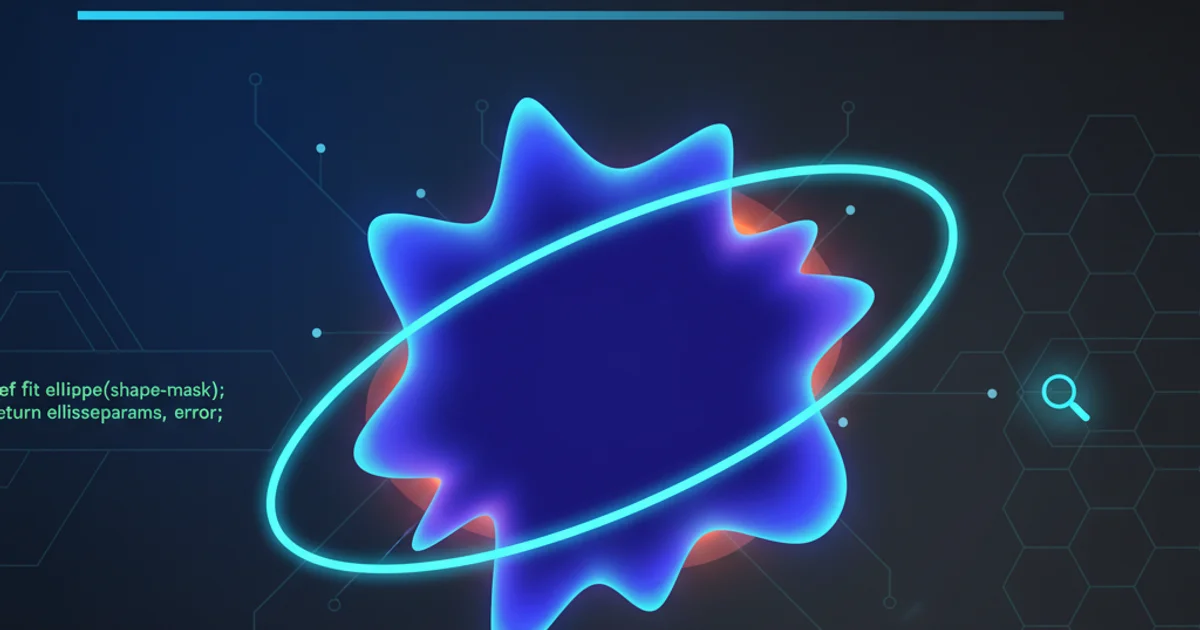Best Elliptical Fit for irregular shapes in an image
Categories:
Best Elliptical Fit for Irregular Shapes in Image Processing

Discover robust methods for fitting ellipses to irregular shapes in images, crucial for object recognition, analysis, and measurement in computer vision applications.
Fitting an ellipse to an irregular shape in an image is a common task in computer vision and image processing. Unlike perfect geometric shapes, real-world objects often present contours that are noisy, segmented, or inherently non-elliptical. This article explores various techniques, from classical least squares to more robust and iterative approaches, to accurately approximate irregular shapes with an ellipse, providing insights into their strengths and weaknesses.
Understanding the Challenge of Irregular Shapes
When dealing with irregular shapes, a simple least squares ellipse fit (e.g., based on moments) might not always yield the most representative result. Irregularities, concavities, or protrusions can significantly skew the fit, leading to an ellipse that doesn't accurately capture the object's primary orientation or extent. The goal is often to find an ellipse that best 'encloses' or 'approximates' the shape, minimizing a certain error metric while being robust to outliers on the contour.
flowchart TD
A[Input Irregular Shape Contour] --> B{Choose Fitting Method}
B --"Least Squares (Moments)"--> C1[Calculate Central Moments]
C1 --> D[Derive Ellipse Parameters]
B --"Iterative/Robust Methods"--> C2[Sample Contour Points]
C2 --> E{Fit Ellipse to Subset}
E --"Evaluate Fit (e.g., RANSAC)"--> F{Is Fit Good?}
F --"No"--> C2
F --"Yes"--> D
D --> G[Output Fitted Ellipse]General workflow for fitting an ellipse to an irregular shape.
Common Approaches for Ellipse Fitting
Several methods exist for fitting ellipses, each with its own advantages and suitable scenarios. The choice often depends on the nature of the irregularity, computational constraints, and the desired accuracy.
1. Moment-Based Fitting
This is a straightforward and computationally inexpensive method. It involves calculating the central moments of the shape's pixel distribution. From these moments, the parameters of an equivalent ellipse (center, axes lengths, orientation) can be derived. While fast, it's highly sensitive to noise and irregularities, as every pixel contributes to the moments.
import cv2
import numpy as np
# Assuming 'contour' is a list of points representing the irregular shape
# Example: contour = np.array([[[x1,y1]], [[x2,y2]], ...])
# Calculate moments
moments = cv2.moments(contour)
# Calculate centroid
cx = int(moments['m10'] / moments['m00'])
cy = int(moments['m01'] / moments['m00'])
# Fit ellipse using OpenCV's minAreaRect (which can be used for ellipse approximation)
ellipse = cv2.fitEllipse(contour)
# ellipse is a tuple: ((center_x, center_y), (major_axis, minor_axis), angle)
print(f"Ellipse center: {ellipse[0]}")
print(f"Ellipse axes: {ellipse[1]}")
print(f"Ellipse angle: {ellipse[2]}")
Python example using OpenCV's fitEllipse for moment-based fitting.
2. Direct Least Squares (DLS) Methods
Direct Least Squares methods aim to minimize the algebraic distance between the contour points and the ellipse equation. These methods are generally more robust than moment-based approaches but can still be sensitive to outliers. Algorithms like Fitzgibbon's method are popular for their speed and accuracy on well-behaved data.
3. Iterative and Robust Methods (e.g., RANSAC)
For highly irregular shapes or contours with significant noise/outliers, robust methods like RANSAC (Random Sample Consensus) are often preferred. RANSAC iteratively selects a minimal subset of points, fits an ellipse to them, and then counts how many other points 'agree' with this fit (inliers). The process is repeated, and the ellipse with the most inliers is chosen. This makes it highly resistant to outliers.
4. Geometric Distance Minimization
These methods minimize the geometric distance (Euclidean distance) between the contour points and the fitted ellipse. While theoretically more accurate, they are often non-linear optimization problems, making them computationally more expensive and requiring good initial guesses. They are less common for highly irregular shapes due to convergence issues.
Pre-processing and Post-processing Steps
To improve the quality of the elliptical fit, especially for irregular shapes, consider these steps:
1. Contour Extraction and Simplification
First, accurately extract the contour of the irregular shape. Techniques like Canny edge detection followed by findContours in OpenCV are common. For noisy contours, consider applying contour approximation algorithms (e.g., cv2.approxPolyDP) or smoothing filters to reduce high-frequency noise before fitting.
2. Outlier Removal
If specific parts of the contour are known to be outliers (e.g., small protrusions not relevant to the overall shape), consider removing them before fitting. This can be done based on curvature analysis or distance from a preliminary fit.
3. Weighted Fitting
Some advanced fitting algorithms allow assigning weights to contour points. Points that are more reliable or central to the shape's overall form can be given higher weights, influencing the fit more strongly.
4. Evaluation and Refinement
After fitting, evaluate the quality of the ellipse. Does it visually represent the shape? Are there large deviations? Depending on the application, you might need to refine the fit or choose a different method if the initial result is unsatisfactory.